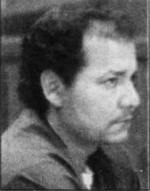 Florida Today (Cocoa, Florida), April 21, 1987. On April 23, 1982, Marc Cobb found his 27-year-old wife, Mary Sue, had been brutally raped, stabbed and strangled to death in their Cocoa, Florida home. She had multiple knife wounds and a butcher knife protruded from her chest. At the time of the murder, 24-year-old Juan Ramos, an acquaintance of the victim, was employed at a manufacturing firm near the victim’s residence. When questioned by the police, he stated that on the day of the murder, he had arrived at work before 7:00 a.m., learned that he had been laid off, and returned to his apartment at 7:10 a.m. He told authorities that as he returned home from work, he noticed an African-American man walking in the street near the Cobb’s home. Ramos was interrogated for approximately seven hours at the Cocoa Police Department. On the following day, the same room was used for two dog scent discrimination lineups, where the only people present were the police chief, a police detective, a sergeant from the sheriff’s office, and the dog handler, John Preston. No one from Ramos’ legal team witnessed the tests. The first lineup consisted of five blue shirts, four that belonged to the husband of the police chief’s secretary and one that was worn by the victim when she was killed. The dog was given a cigarette pack that belonged to Ramos and was allowed to sniff each shirt in turn. The dog indicated that shirt no. 5, the one belonging to the victim, was the shirt in question. The lineup was repeated and, again, the dog indicated shirt no. 5. The second lineup consisted of five knives, three which belonged to a local diner, one belonging to a police officer, and one that was imbedded in the victim’s body. The dog again sniffed the cigarette pack and selected knife no. 3, the knife found in the body of the victim. This, too, was repeated, with the same results. While the evidence seemed powerful, the lineups were neither accurate nor reliable. In the first lineup, Mary Sue Cobb’s blouse was the only one that belonged to a woman and the only one with blood on it. In the second lineup, the knife found in her body was also the only one where blood was present. Another key part of the state’s evidence came from Ramos’ former jail cellmate, James Gilmer, who testified that shortly after the murder, Ramos had told him that he had wanted to go to bed with Mrs. Cobb. According to the defense, however, not only was Gilmer a convicted felon, he also “had traded his testimony against Ramos for a probationary sentence on a series of crimes he had been accused of.” Under questioning, Gilmer acknowledged that while he had been facing 70 years in prison for various felonies, he had served only two of those years before testifying against Ramos. No forensic evidence tied Ramos to the victim. None of the hair samples collected at the crime scene matched Ramos’ hair. Although witnesses reported seeing a Cuban man running through a nearby orange grove, Ramos testified that, after discovering that he had been laid off, he spent the day with his wife. Despite the lack of reliable evidence, Ramos was convicted of first-degree murder. Although the jury had recommended a life sentence, Brevard County Judge William Woodson overrode the jury and sentenced Ramos to death. In 1987, the Florida Supreme Court vacated the conviction and ordered a new trial because of evidence improperly used against the defendant. The Court found that the dog scent lineup had not been conducted in a fair, objective manner and noted that the dog had failed a subsequent test, raising questions about whether or not the dog had been properly trained. This specific dog had been featured on a 1985 20/20 special, which focused on errors by John Preston and highlighted that this same dog had several times identified suspects who were likely innocent. The court found that the dog scent evidence should not have been admitted at trial. Ramos was acquitted on retrial in April 1987. Norman Wolfinger, Ramos’ public defender, cited the case as “the weakest murder case I’ve ever seen. Absolutely no attempt was made from Day One to pin the murder on anyone but the sap, the Cuban.” – Rachel Schastok and Dolores Kennedy
|